万发屯
吃喝玩乐奔诺奖
正文
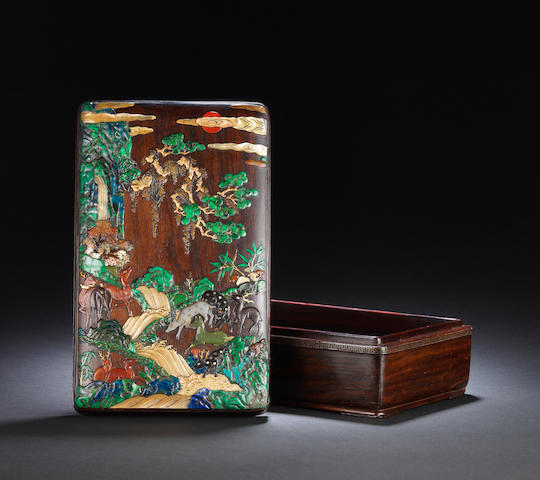
Lot 33
An exceptional finely-inlaid 'hundred deer' zitan box and cover
Kangxi
Sold for HK$ 8,440,000 (£745,857) inc. premium
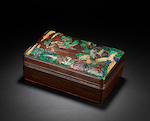
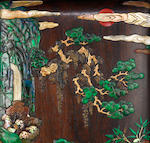
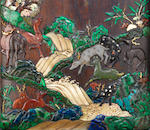
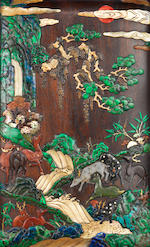
An exceptional finely-inlaid 'hundred deer' zitan box and cover
Kangxi
The cover skilfully embellished with delicate colourful sheets of inlay in various vivid media including mother-of-pearl, malachite, nephrite, soapstone, gilt-bronze, carnelian, and carved wood, depicting a herd of dotted and striped deer gambolling and resting in a lush landscape encircled by fast-flowing and swirling streams cascading from jagged rocks amidst wutong, bamboo, lingzhi and narcissus, below a gnarled pine branch with overhanging wutong branches growing from the top of the cliff, all under a red lacquered sun partially obscured by clouds, all inlaid on the zitan ground, the rim of the cover and box finely inlaid in silver wire to form a key-fret border, the wood of attractive reddish-brown tone with characteristic streaks, the box raised on four bracket feet, fitted box.
28.5cm x 17.8cm (11in x 7in) (3).
The cover skilfully embellished with delicate colourful sheets of inlay in various vivid media including mother-of-pearl, malachite, nephrite, soapstone, gilt-bronze, carnelian, and carved wood, depicting a herd of dotted and striped deer gambolling and resting in a lush landscape encircled by fast-flowing and swirling streams cascading from jagged rocks amidst wutong, bamboo, lingzhi and narcissus, below a gnarled pine branch with overhanging wutong branches growing from the top of the cliff, all under a red lacquered sun partially obscured by clouds, all inlaid on the zitan ground, the rim of the cover and box finely inlaid in silver wire to form a key-fret border, the wood of attractive reddish-brown tone with characteristic streaks, the box raised on four bracket feet, fitted box.
28.5cm x 17.8cm (11in x 7in) (3).
Footnotes
- 清康熙 紫檀百寶嵌松鹿雙壽圖盒
Provenance 來源:
Sotheby's Hong Kong, 17 May 1989, lot 348
香港蘇富比,1989年5月17日,拍品348
Published and Illustrated 出版:
Sotheby's Hong Kong Twenty Years, Hong Kong, 1993, p.260, pl.407
Sotheby's Thirty Years in Hong Kong, Hong Kong, 2003, p.347, pl.407
《香港蘇富比二十週年》,香港,1993年,頁260,圖407
《香港蘇富比三十週年》,香港,2003年,頁347,圖407
This exquisite box and cover belongs to a group of inlaid objects typically applied on precious zitan or huanghuali wood. This inlay technique is often referred to as Baibao qian or 'One Hundred Precious Objects Inlay'. The term is derived from the multiple and diverse materials used in creating the decoration, including jade, agate, malachite, soapstone, carnelian, mother-of-pearl, tortoiseshell and lacquer. The use of such a wide variety of materials to compose a pictorial scene, results in a stunning effect of vibrant colours and different textures, which as demonstrated by the present lot, accomplishes great complexity and depth. Works of art made employing this technique required the sourcing of expensive semi-precious materials as well as the prized zitan wood; combined with the masterful craftsmanship that would have been required, such objects would have been very costly to produce.
This technique was used to a great effect during the late Ming dynasty, as demonstrated in a number of inlaid zitan and huanghuali wood boxes from the Qing Court collection, illustrated in The Complete Collection of Treasures of the Palace Museum: Bamboo, Wood, Ivory and Rhinoceros Horn Carvings, Hong Kong, 2002, pls.219-225, with some works in this style associated with the renowned master carver Zhou Zhu.
For early Qing dynasty examples from the Palace Museum, Beijing, compare an inlaid zitan box and cover, of similar rectangular form with decoration featuring a hunting scene, also with silver wire inlay around the rims, but rendered in a slightly different key-fret band; and see an inlaid zitan tiered picnic box and cover, with a design of egrets amidst lotus and very similarly designed silver-wire inlay key-fret bands to the rims, from the Qing Court collection, illustrated ibid., pls.226 and 230.
The present example, in its outstanding decoration of deer within a landscape, reflects the highest level of workmanship achieved during the early Qing dynasty. The brilliance of the master craftsman is evident in how naturalistic the scene appears. Consider how the flowing river with splashing waves is rendered with a wonderful sense of movement, or how elegant the vines and leaves trailing from the gnarled pine branches are. Remarkably, despite each component being carefully carved separately and then assembled together to form the scene, inlaid decoration during the Kangxi period illustrates a distinctively free and elegant quality. The individually carved deer are also exceptional, each in different poses, detailed with carefully incised fur and expressive eyes.
The multiple deer depicted on the present box elude to the popular 'hundred deer' motif, bailu, which is a homophone for 'hundred emoluments', representing the wish 'May you receive the hundred emoluments from heaven'. Deer were also regarded as symbols of longevity due to their long life spans and ability to find lingzhi, the fungus of immortality. The decoration on the present box, with deer depicted together with pine trees and rocks that are also symbols of longevity, presents a multitude of auspicious wishes.
盒以紫檀製作,長方形,蓋與盒口沿嵌銀絲迴紋,蓋面以百寶嵌松鹿雙壽圖,九鹿形態各異, 於山石壽松下憩息。整盒形制規整,蓋邊圓潤雅緻,蓋面以松石及青金石嵌山石、松針,螺鈿嵌流水、雲彩,再以玳瑁、瑪瑙、大漆等原料嵌九鹿及樹幹,上空一輪 紅日於雲中,鑲嵌細緻,構圖講究,巧奪天工。
百寶嵌製品設計原料繁多、加工複雜。根據所屬材料不同,需要經過冶鑄、鏨刻、碾磨、雕刻、調 色、配漆等等工藝才能完成,不僅需要珍貴材料,更需要多種工藝技巧相互配合。由於其對材料及工藝的要求極高,唯宮廷作坊才能達成,因此成為了明清宮廷中一 種特殊的藝術門類。明代末期,百寶嵌工藝已開始盛行,其中以明人周柱之工藝為聞名,故宮博物院中所藏明代之例子,見《故宮博物院藏文物珍品全集?竹木牙角 雕刻》,香港,2002年,圖219-225。
清代初年的百寶嵌延續明末風格,鑲嵌更加精細,紋飾主題更多樣化,除花鳥以外,出現雲龍、 八仙、百鹿、人物故事等紋飾。北京故宮博物院中所藏一件清早期紫檀百寶嵌狩獵圖盒,其綠松嵌山石及螺鈿所嵌雲紋之工藝與本盒極為相似;另參看一件紫檀百寶 嵌蓮藕紋拜匣,其口沿所嵌之銀絲迴紋與本盒類似,兩件器物均著錄於《故宮博物院藏文物珍品全集?竹木牙角雕刻》,香港,2002年,圖226及230。
此盒鑲嵌工藝極其考究,為清早期同類紫檀百寶嵌中頂級之作。不論山石、馴鹿或是樹幹、雲彩,每個部件之刻畫均一絲不苟。匠工可將如此之多以不同材料雕刻之部件組合並鑲嵌,最終形成一幅生動如畫的嵌百寶畫面,實為康熙一朝之神工鬼斧也。 















评论
目前还没有任何评论
登录后才可评论.




